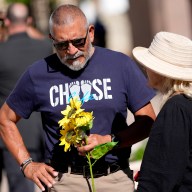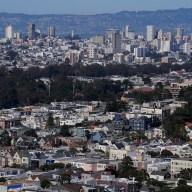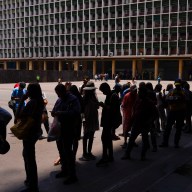 The Water Club reopened in October 2013, one year after being destroyed by Superstorm Sandy.
The Water Club reopened in October 2013, one year after being destroyed by Superstorm Sandy.
Credit: Miles Davis, Metro
October 2012 changed the face of New York City permanently after Superstorm Sandy. Martin Connor, maitre d’hotel of The Water Club, knew after 2011’s Hurricane Irene that his workplace was in for some serious damage. But none of those who went to work that day could have anticipated that their livelihood, a Manhattan establishment since 1982, would be out of business for an entire year.
Although The Water Club officially reopened in October 2013, Memorial Day Weekend marked the start of its first summer back in operation. With busy season upon him — and the long-awaited re-opening of The Crow’s Nest, a rooftop bar — Connor sat down with Metro for an exclusive account of the life-threatening drama that unfolded when his staff was trapped in the flood during New York’s second deadliest storm. In his own words:
 The Water Club was gearing up for a busy holiday season when Sandy struck on Oct. 29, 2012.
The Water Club was gearing up for a busy holiday season when Sandy struck on Oct. 29, 2012.
Credit: Provided
Before the storm
Our plan was innocent until proven guilty: We are open until Mother Nature tells us directly otherwise, according to our owner, Michael “Buzzy” O’Keeffe. That’s a philosophy that I’m OK with, to a certain degree. We had a big party planned for that Monday. We were going to host a huge party for the Irish Embassy, and we were very nervous about it. We did everything to reassure them that we were ready, but at the same time reminded them that something could happen. They were pushing us to stay open. They didn’t want to cancel their big event, which is understandable.
The rain started light Sunday morning. The tides were a little higher, and so were the waves, but nothing serious, so we opened for brunch. The city had at that time developed a more cautious posture; Bloomberg was probably responsible for that. One of the measures he did take was to shut down the subway system around 3 o’clock that afternoon. It became apparent to me that I had to send home the staff. We canceled our big event. We had everyone out of the restaurant by 5 o’clock and began to make emergency plans.
I talked to Buzzy a few times, and it quickly became apparent to me that he expected me to stay. I went home and got my father’s Jeep. I was a Boy Scout, so I had a couple of tricks up my sleeve. I grabbed my headlamp and whatever I thought might be of immediate necessity —a sleeping bag and other supplies that would hopefully last for a few days — and returned to the restaurant.
 A perfectly set table juxtaposes the water-logged floor boards and damaged property after the water receded.
A perfectly set table juxtaposes the water-logged floor boards and damaged property after the water receded.
Credit: Provided
Sunday night
A small team of qualified workers stayed over Sunday night, including facilities manager Willie Gonzalez and Rupert Garbutt, maintenance department supervisor. We were up most of the night preparing everything. We didn’t know exactly when the storm would hit, but essentially we had to remove all the compartment tops and the barges, all the wood panels on the floor, and expose the ballast tanks.
We had a small team of extremely qualified workers who stayed with us, people who had been here for years and years with the company. Honestly, it reminded me of the way the city has come together after other disasters, including 9/11. There was the need to look out for one another and to continue to provide for families and make sure they were safe. And when I saw that bravery, I knew that they weren’t taking this lightly in any sense. I wouldn’t have trusted my life in anyone else’s hands at the time. But we would never have asked anyone to stay there if we weren’t staying ourselves.
 The East River rapidly began to rise beyond the expectations set by Hurricane Irene in 2011.
The East River rapidly began to rise beyond the expectations set by Hurricane Irene in 2011.
Credit: Provided
Monday morning
Monday was a very tense day. We decided to sandbag the place up as best we could. That morning at low tide was as high as it was at high tide the previous year for Irene. We knew we were going to be flooded. So we went into emergency mode. I must have made 15 runs down to a place under Manhattan Bridge that sold sandbags. I drove back and forth, and we did our best to cover the whole place.
As arrogant it may seem, I never miss a good adventure. I don’t mean that as disrespect to people who have lost their lives in similar situations. I wasn’t particularly scared. I know how to swim. I’ve been in emergency situations before. Obviously I know I could die, but I also trust myself. We had a protocol. When you deal with an emergency, the most important thing is self-awareness. You are dealing with forces that are out of your control, and as long as you’re willing to accept that fact and work around it, you have a very good chance of accomplishing what you’re hoping to accomplish.
 The cars of employees were parked here, in the front parking lot, for fast evacuation.
The cars of employees were parked here, in the front parking lot, for fast evacuation.
Credit: Provided
Monday afternoon
Our plan was to get in the cars and drive away while we still had time. We sandbagged everything, we pulled the trigger, we pumped the barges full of water — this is happening from about noon until 4 p.m. At this point, Buzzy is on the phone with me constantly. He said he would be coming over, because his other property, The River Cafe in Brooklyn, was starting to go under. He came here and parked his car right out front. We have my Jeep, his Mercedes SUV and Willie’s Navigator. The plan was, when the water came up 4 or 5 inches on the tire, we’d go.
Buzzy got here after a horrifying experience across the river, and we had a pot of soup on the stove. We sat him down and gave him a bowl. We were finishing up the operations. We were steadily watching the water rise. We knew high tide was at 5:45 p.m. But at 4:45, it got really bad. Buzzy was still eating his soup. I was watching the tires on the car as the water came up 4 inches. I grabbed Buzzy and told him it was time to leave. He took one look and said, “All right, let’s go.”
 Floor-to-ceiling windows and wood paneling in the dining room made the infrastructure especially vulnerable to the oncoming storm.
Floor-to-ceiling windows and wood paneling in the dining room made the infrastructure especially vulnerable to the oncoming storm.
Credit: Provided
Rising tide
Each of us moved our cars to the last patch of dry land, which was by our dumpsters. I think it was about 20 feet from the front door. Willie came out to move his, and at that point he tripped and fell into the water. He insisted on going back inside to repair his remote starter with a hair dryer. We went back in and up to the second floor, which wasn’t under water, and plugged the hair dryer in against all better sense. Willie tried to dry his keychain enough to get it started. Buzzy is back upstairs. We have two things left to do. We have already shut the fire hydrants off. The porters who went through it last year didn’t have the mentality to mess around with the storm. They had all of their belongings with them, and we were patiently waiting by my car. At that point, the water was at the engine in Willie’s car. I told him: “Willy, if we don’t move your car, you’re never going to get it started.”
I rallied the troops, and the porters and I pushed his car. I have pushed cars before, but pushing that car in 3 or 4 feet of water was the most difficult thing I’ve ever done. We managed to get it uphill. The resistance was unbelievable. Willie comes back out to try his car again. And this isn’t a stretch to the truth, but he tripped a second time. Now we’re 30 minutes past our “go” time. And it’s looking very, very iffy. At this point, the porters have no interest in going back inside. They’re standing by our cars and just waiting to evacuate. I go back in with Willie, and he tries one more time with the hair dryer. At a certain point, I say that we have to go. I was standing in the bar and just watching it rock. The water was foaming up form the red carpet. I will never forget the image of standing and looking into the dining room where I had worked for the last few years, and just see East River water foaming up through the cracks in the wood and through the holes in the red carpet — the whole thing rocking and shaking.
 Connor stepped outside to assess the tide before the storm touched down on NYC.
Connor stepped outside to assess the tide before the storm touched down on NYC.
Credit: Provided
Reality check
That was the first point at which the reality of the situation really struck home. It was literally like seeing your world shaking. Not only rocking, but flooding. The power was going off, and it was one of those moments when — your life doesn’t flash before your eyes, there’s not time for that. But it’s one of those moments where quite the opposite happens. You start to go blank. It’s the only thing you can do to continue the situation in a logical way that will promote your health and safety and future survival. You certainly go through that moment where you become overwhelmed by it all. But there’s always that point where you click back in and say: “This in incredible, this is extreme, this is awesome. I need to get going now. I need to get as far away from this as I can.” And that moment struck.
At that point, Buzzy and I killed the main electric switch. I won’t forget standing in knee-deep water and thinking: “I hope I don’t get electrocuted.” I pulled the switch, and all of a sudden it was like a disaster movie. All the emergency lights came on, and it was very creepy. The siren was going in the background; it goes when you turn the electricity off. I sent Buzzy out the service door, and I went out the bar door. I came to the water out front, and at this point it’s waist-deep. It was above my belly button, and I’m 6-foot-2. I get over to the cars, and no one knows what to do now. We’re trapped. Our cars were on the last patch that could be called dry land. No one seems to be taking any initiative. I have only one foreseeable hope of getting my car and the people in it out of here, and that’s to drive backwards on the service road 15-20 feet, get on to the FDR ramp. At this point we would have been able to make it to 42nd Street.
 By the time staff volunteers were ready to evacuate, the river had already flooded the parking lot out front.
By the time staff volunteers were ready to evacuate, the river had already flooded the parking lot out front.
Credit: Provided
Heading home
My girlfriend at the time was on 14th St. and Avenue C. I was hoping to get back to her, pick her up and get back to Brooklyn. That was a bit of a stretch. I think at that point we would have been happy just to get away from the coast. We just had to get inland at any cost. We were still at the point where we still hoped to salvage a few of our material possessions along with our lives. I volunteered to drive into the water with the Jeep and see if I could get far enough before my engine stalled to make it on to the FDR. I was about three feet short in the car with myself and one of our stewards, Manny, when sure enough the engine choked up on me.
All the lights went on all of a sudden in the dashboard. I sat there in this car, which I’d had for the last 10 years — it was actually my family car — and I had no idea what to do. I just looked at Manny and we just stared at each other for 10 or 15 seconds, and the water is rushing in at this point over the sides. The volume of the flooding is increasing drastically every minute. We all of a sudden feel the car starting to float and turn sideways. I immediately said: “Manny, open the door!”
As soon as we opened our doors the water washes in over my knees. It was one of those unbelievable feelings. Your car has been your safety net most of your life in a very psychologically profound way, and all of a sudden when you open that door the water is above your thighs. You know you have to get out into it to get away. Our first instinct was to try and push my car back out of the water. So we started pushing. And we had to turn it around. I had one hand in turning the wheel, which had already jammed. And there was not much we could do, but we were trying. Streetlight bulbs started to pop as the power grids became exposed to the water.
That the first time all night that I thought I could actually die right now. This could be it! I wasn’t worried about the water or the cold — in retrospect I foolishly wasn’t worried about anything — but as soon as those street lamps started to pop, it became quite apparent to me that it would be pretty easy to die from electrocution. So we scrambled. It was the first time all night I felt panicked and my heart started racing. I had to get out of the water as quickly as I could. There was this standard concrete dividers alongside the road. The water was so high you couldn’t see those. Half walking and half swimming as fast as we could, we both hit one of them, and both of us fell in. It was just invisible beneath the water. We made our way to the nearest building, the Waterside Plaza.
 Connor’s Jeep was engulfed by rising tides before the current began to sweep it away from the street.
Connor’s Jeep was engulfed by rising tides before the current began to sweep it away from the street.
Credit: Provided
Safe harbors
When he saw my car starting to float, Buzzy tried to come in after us and help us get out of the car, and he was pulled under by the current. It was hard to distinguish between the waves on the river and those on shore. The flooded area was an extension of the river. Buzzy was sucked right under. A few of the porters went after him. I didn’t know where they were, and we were all trying to call each other, but our phones had gotten wet and weren’t working. I remember my iPhone was just flickering. I was able to pick up a couple of calls, but they were dropped immediately. We weren’t sure were Buzzy was. And at that point, I didn’t even know if the rest of them were alive. But eventually we were all able to reconvene upstairs at the Waterside Plaza.
At that point, I was really worried about my girlfriend Joanna. And I decided against all better judgment to get to her. And I knew the only way back out was across the footbridge on 25th St. So I walked across the footbridge, and at that point the wind had picked up. I remember just being knocked into walls; I could barely stand up. When I reached the other end of the bridge, it became apparent that I had to go into the water again. I put my backpack over my head, and I went into the water that ended being about armpit-deep. I couldn’t see anything, and had no idea where my footing was, and I used a fence to walk myself up to First Avenue. I’ll never forget coming out of the water dripping and people taking photos of me as I walked out.
At that point, the wind was picking up severely and there were street signs blowing past me. It was one of those moments where you get to stare Mother Nature in the face. It doesn’t happen every day. I just started sprinting as fast as I could. I sprinted all the way from 20th Street to 14th Street. In order to get to my girlfriend, I had to head left and back into the flooding. I realized that I had to get back into the water to get into the entrance of her building, which was, luckily, up a flight of stairs. So I went back into the water for a third serious time again with my backpack over my head. I rounded the corner and made it to her building. At that point the lights were still on. Thank goodness!
I made it upstairs, but my phone wasn’t working — it had been destroyed when I went back into the water from the pedestrian bridge. So when I got there, I didn’t know where she was and if she was freaking out and looking for me. But we ran into each other on the first floor and we went up to her apartment. I took a cold shower and she made me some chicken, which was probably the best thing I had tasted in two days. And just as I sat down to take the first bite, there was a giant flash from the window. And the power plant across the street blew up right in front of our eyes. Two or three seconds later, the power dimmed. And that was it: No more electricity. We lit some candles and quickly fell asleep. I was just exhausted. The next morning we got up and hiked back to The Water Club.
 The Water Club was a danger zone of destruction and debris following Sandy.
The Water Club was a danger zone of destruction and debris following Sandy.
Credit: Provided
The aftermath
It was a grueling two days as the storm surge receded. All our generators had been flooded. My car was gone, obviously. I borrowed a friend’s SUV and we found one of the last generators for rent in New York. We had already risked our lives to save the restaurant, but unless we were able to get a generator in here the next morning and pump the water out, our barges could sink anyway. So it would have all been for nothing if we didn’t get a generator and get it over to The Water Club and pump — which we did over the next two days.
It was one of the most traumatic experiences I have ever had. After the hurricane I had some nightmares, and to be perfectly honest, most of those nightmares was about leaving that car. That was the first time it occurred to us that the storm might get the better of us. Up until that point we were in control. When I abandoned that Jeep, I was no longer in control. I was on foot and felt desperate.
 The kitchen was beyond repair, with insulation from the walls and floor torn apart and tossed throughout the once-sterile environment.
The kitchen was beyond repair, with insulation from the walls and floor torn apart and tossed throughout the once-sterile environment.
Credit: Provided
One year in limbo
We never expected to be closed for a year. We expected to be open by the next week. I became apparent that next morning that even our most pessimistic expectations had been exceeded. And the storm had really put us in a place where we had to rebuild nearly from scratch in many cases. Most of the infrastructure was destroyed. No heat, no water, no electricity. It was hard.
I met all staff and told them that, frankly, we had been destroyed. But our first priority was to take care of the people who made this company what it was. We tried to give them the support we could to take care of themselves and their families. I can’t tell you how many letters of recommendation I wrote. There is nothing more painful than to help your best senior staff by placing them at other jobs. I can’t tell you how many employees I had to turn away at the door the days after the hurricane. They just wanted to come in free of charge to help us. We were in no position, structurally, to let anyone back into the building. It was a disaster area, and they were physical hazards everywhere.
 It wasn’t until Connor began to inspect the damage for insurance reconciliation that he realized he would be out of business for a long time.
It wasn’t until Connor began to inspect the damage for insurance reconciliation that he realized he would be out of business for a long time.
Credit: Provided
Looking back
One of the best ways I can sum it up is: Any endeavor worth undertaking, if you don’t approach it with passion and pride, you’re not gonna do a good job, and it’s not gonna be worthwhile to you or to anyone else it affects. Being here for that hurricane and preserving that restaurant was not only one of the bravest things I’ve seen anyone do, but it was also a testament to the pride we all shared for this establishment and its 30-year tradition.
The aftershocks come later. The fear can set in during the experience, but it’s not emotionally compromising until afterward. A lot of us cried next day when we came back here and saw what the storm had done to this place. We realized that we would not be open for a very, very long time. I cried. I did. And a lot of people did. It was very sad, but by the end of the day we were all working on cleaning up. And we didn’t have time to stop. Tuesday morning at 8 or 9, we were back here taking photos of the damages. By the afternoon we had to get a generator and start pumping. We knew we only had one tide cycle until we were structurally compromised. We didn’t have a lot of time to recoup after that life-threatening experience. We had to keep moving. And that may not have been the healthiest way of approaching it, to jump right back into the work, but it certainly gave us a basis to start moving on.
The Water Club reopened in October 2013. To make reservations, call 212-683-3333 or visit www.thewaterclub.com.
The Crow’s Nest, its rooftop bar, reopened in May 2014. Read about it here.
Follow T. Michelle Murphy on Twitter: @TMichelleMurphy.














